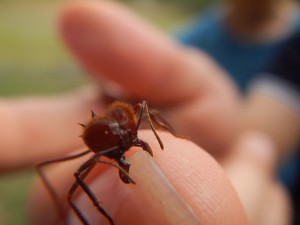Today was a day ant. I was lucky enough to identify at least four species that I am familiar of. Our assignment to find the defense mechanism of juvenile cecropia tree naturally led me to find Azteca alfari which forms mutualistic symbiosis with the tree. Very fortunately, I was able to find a queen in the top compartment of a small branch. This confirmed that Azteca base center of the colony at the top of the tree. The queen was massive compared to the workers and I could even take pictures of larvae and recently developed nymphs.
 (Azteca ant queen)
(Azteca ant queen)
On the road we found army ants, Eciton burchelii. The swarm had few soldier castes which were at least 3 cm long counting its massive and sickle like mandibles. Hopefully I can find a bivouac of the army ants while I am here. On an acacia tree, I found Pseudomyrmex as expected but also on a different tree, Poniponera had formed a colony inside, which is unusual. Near by the open disturbed area where young cecropia were growing, I found Cephalotes ant with distinctive stout looking head and short abdomen. I was hoping to find one of those ants. Afternoon, I finally got to see the soldier caste of Atta cephalotes. They were indeed huge and the mandibles were sharp enough to pierce through my skin.
As for the project regarding defense mechanism of juvenile cecropia, our group hypothesized that there would be a physical differences between the leaves of juvenile and mature (or already colonized) cecropia. The leaves of the juveniles were indeed smaller and could withhold more weight than the larger leaves of the mature individuals. this result connected to the further hypothesize that juvenile cecropia have tougher leaves that makes herbivory less cost efficient and thus predators will consume the juveniles in lesser frequency.
Story of an A. cephalotes colony
The sky above the Belizean rainforest before the wet season becomes a royal ballroom of the Atta drones and to-be-queens. A queen successfully mated with multiple drones, filling her abdomen with sperms that will be used for next 20 years of her reign to produce millions of daughters. The queen dug down an open ground and horizontally to start her colony.
From the eggs, minor workers hatched and dug out from the first lair, shedding light for the first time in a while. Their first job is to bring in food for the fungi pallet that the queen brought as her dowry from the mother colony.
It has been 6 years since the queen first dug the colony. The fungi farm is successful and hatchery is busy producing major worker ants. But the colony as met challenges. Last summer some group of human came and ravaged her colony, exposing their pupae and larvae, and precious fungi to who knows what pathogens that will devastate their farm. The queen decided that their production yield, food surplus, and size were ripe to produce the soldiers.
Year 15, the colony has dominated the surrounding area. The soldiers effectively deter the predators and the workers bustle through the highway carrying food for their fungi plantation. The old empress has produced many queens that some of them already established daughter colonies in different regions of the forest. And yet again, the empire met with challenge of human intruders. Many precious soldiers were mailed and workers spent a whole day reconstructing the tunnels and rooms that were destroyed.
Year 21, the queen died. The workers lost their purpose once the last larvae hatched. Day after day old workers died but none hatched to replace them. The great Atta Empire fell as the last worker was eaten by a hungry bird.


